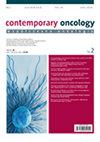The association of complementary alternative medicine use with anxiety, depression and quality of life in Turkish cancer patients
IF 2.9
Q2 ONCOLOGY
引用次数: 3
Abstract
Aim of the study: The purpose of this study is to investigate the complemen tary/alternative medicine (CAM) usage and the factors affecting this among can cer patients in the western region of Turkey. 220 adult cancer patients par ticipated in the study and 93 patients (42.3%) were found to use at least one CAM method. Material and methods: Our study was done by face-to-face communication in auniversity hospital, in Turkey. Oncolo gy patients’ primary diseases, sociode mographic characteristics, complemen tary alternative medicine usage, psychological conditions and quality of life were evaluated with proper psy chological scales. Patients using and not using CAM were compared with re spect to Beck Depression, State Trait Anx iety and Beck Hopelessness scores. No statistically significant difference was de tected between/among the groups in BDI (12.0 ±8.4, 11.9 ±8.7, p = 0.96), BHS (5.5 ±4.9, 4.8 ±4.4, p = 0.27) or STAI (43.7 ±8.0, 44.3 ±8.2, p= 0.64) scores. Pa tients using and not using CAM were compared with respect to WHOQOLBREF quality of life scores. There was no statistically significant difference be tween/among the groups in WHOQOLBREF sub-group scores (physical, psy chological, social relations, environment, standardized by culture (environment), general health). Results: Nearly half of the patients (42.3%) in this region were found to be using at least one of the CAM methods. The patients mostly preferred herbal methods, with the leading product be ing stinging nettle ( Urtica dioica ). The severity of disease (recurrence and dis semination) and patients’ knowledge of the diagnoses were the most important factors affecting the CAM usage. Conclusions: The usage of CAM by on cology patients and the effects of CAM on the present medication prescribed by oncology practitioners must be remem bered when they are admitted to poly clinics. Also it must be known that pa tients with advanced stage and patients with recurrence are more likely to use complementary alternative medications than early stage patients. Therefore on cology patients must be informed about CAM besides their clinical situations. At least physicians should give answers about the CAM to their patients.土耳其癌症患者的焦虑、抑郁和生活质量与补充替代药物使用的关系
研究目的:本研究的目的是调查土耳其西部地区癌症患者的补充/替代医学(CAM)使用情况及其影响因素,共220例成年癌症患者参与研究,其中93例(42.3%)患者至少使用一种CAM方法。材料和方法:本研究在土耳其一所大学医院采用面对面交流的方式进行。采用适当的心理量表对肿瘤患者的原发疾病、社会地理特征、辅助替代药物使用情况、心理状况和生活质量进行评估。比较使用和不使用CAM的患者在贝克抑郁、状态特质焦虑和贝克绝望方面的得分。各组间BDI(12.0±8.4,11.9±8.7,p= 0.96)、BHS(5.5±4.9,4.8±4.4,p= 0.27)、STAI(43.7±8.0,44.3±8.2,p= 0.64)评分差异均无统计学意义。比较使用和未使用CAM的患者的WHOQOLBREF生活质量评分。各组间WHOQOLBREF亚组评分(生理、心理、社会关系、环境、文化标准化(环境)、一般健康)差异无统计学意义。结果:该地区近一半(42.3%)的患者至少使用了一种CAM方法。患者大多选择草药治疗,主要产品为荨麻(荨麻)。疾病的严重程度(复发和传播)和患者对诊断的了解程度是影响CAM使用的最重要因素。结论:肿瘤科医师就诊时应牢记肿瘤患者使用CAM的情况及CAM对现有药物的影响。此外,必须知道,晚期患者和复发患者比早期患者更有可能使用补充替代药物。因此,除了患者的临床情况外,还必须让他们了解辅助治疗。至少医生应该给他们的病人关于CAM的答案。
本文章由计算机程序翻译,如有差异,请以英文原文为准。
求助全文
约1分钟内获得全文
求助全文
来源期刊
CiteScore
3.10
自引率
0.00%
发文量
22
审稿时长
4-8 weeks
期刊介绍:
Contemporary Oncology is a journal aimed at oncologists, oncological surgeons, hematologists, radiologists, pathologists, radiotherapists, palliative care specialists, psychologists, nutritionists, and representatives of any other professions, whose interests are related to cancer. Manuscripts devoted to basic research in the field of oncology are also welcomed.

 求助内容:
求助内容: 应助结果提醒方式:
应助结果提醒方式:


